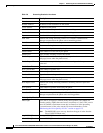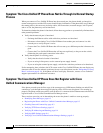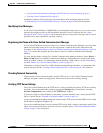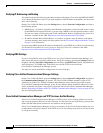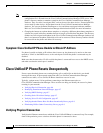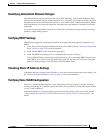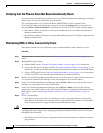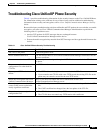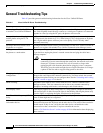
8-3
Cisco Unified IP Phone 7960G/7940G Administration Guide for Cisco Unified Communications Manager 7.0 (SCCP)
OL-15498-01
Chapter 8 Troubleshooting and Maintenance
Resolving Startup Problems
• Cisco Unified Communications Manager and TFTP Services Are Not Running, page 8-4
• Creating a New Configuration File, page 8-5
In addition, problems with security may prevent the phone from starting up properly. See the
“Troubleshooting Cisco Unified IP Phone Security” section on page 8-9 for more information.
Identifying Error Messages
As the Cisco Unified IP Phones 7960G/7940G cycle through the startup process, you can access status
messages that might provide you with information about the cause of a problem. See the
“Status
Messages Screen” section on page 6-3 for instructions about accessing status messages and for a list of
potential errors, their explanations, and their solutions.
Registering the Phone with Cisco Unified Communications Manager
A Cisco Unified IP Phone can register with a Cisco Unified Communications Manager server only if the
phone has been added to the server or if auto-registration is enabled. Review the information and
procedures in the
“Adding Phones to the Cisco Unified Communications Manager Database” section on
page 2-7 to ensure that the phone has been added to the Cisco Unified Communications Manager
database.
To verify that the phone is in the Cisco Unified Communications Manager database, choose Device >
Phone > Find from Cisco
Unified Communications Manager Administration to search for the phone
based on its MAC Address. For information about determining a MAC address, see the
“Determining
the MAC Address for a Cisco Unified IP Phone” section on page 2-12.
If the phone is already in the Cisco Unified Communications Manager database, its configuration file
may be damaged. See the
“Creating a New Configuration File” section on page 8-5 for assistance.
Checking Network Connectivity
If the network is down between the phone and the TFTP server or Cisco Unified Communications
Manager, the phone cannot start up properly. Ensure that the network is currently running.
Verifying TFTP Server Settings
The Cisco Unified IP Phone uses the TFTP Server 1 setting to identify the primary TFTP server used by
the phone. You can determine this setting by pressing the Settings button on the phone, choosing
Network Configuration, and scrolling to the TFTP Server 1 option.
If you have assigned a static IP address to the phone, you must manually enter a setting for the TFTP
Server 1 option. See the
“Network Configuration Menu” section on page 4-4.
If you are using DHCP, the phone obtains the address for the TFTP server from the DHCP server. Check
the IP address configured in Option 150.
You can also enable the phone to use an alternate TFTP server. Such a setting is particularly useful if the
phone was recently moved from a from one location to another. See the
“Network Configuration Menu”
section on page 4-4 for instructions.






